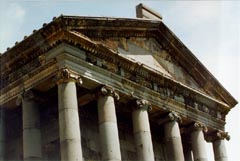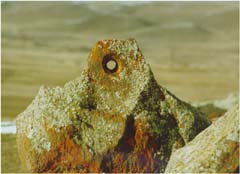|
More than fifteen years of study has been focused on the stones
at Sissian, beginning in the 1980's when archeologists first
uncovered mausoleums at the site. Before then, the site
wasn't more than a curiosity, though in the 19th century it
was endowed with fertility powers—pictures taken in the 1890's
show women lying prone across stones in an effort to "cure bareness".
Sissian
was not alone in holding prehistoric and ancient stones endowed
with supernatural powers. Three caves in Vayots Dzor region
were renowned for the fertility properties of certain stalactites.
Even today pagan rituals are preserved, including "Matagh" (sacrifice)
and tying bits of clothing to trees near churches in a sort
of "wish tree" or "burning bush" ritual. Supplicants,
especially from villages, still follow pre-Christian rites of
walking seven times clockwise (i.e. the path of the sun encircling
around the earth) around a church wile praying and holding a
sacrificial animal. Steeped in tradition, the Armenian
church—just as the church in Rome—usurped pagan traditions and
converted them to a Christian purpose, but they exist underneath
all the same. Almost all 4th-7th century churches were built
over pagan temples, carefully preserving pagan traditions of
orienting the altar to the East, the entrance to the West and
following a strict sacred numerology of constructing churches
on a ratio of 1 to 2 and 1 to 3. 
The superstitions
surrounding sites like that at Sissian made the archeological
discoveries in the 1980's all the more profound. But it
also opened a controversy around the reason for the stones,
and just how old they are. Archeologists excavating site
said the age of the site—including the stones—to be mid 3rd
millennium BC, but the reason for the stones was never fully
explained.
Parsamian
and her assistant Alexander Barsegian conducted the first astronomical
study into its mysteries in 1983. Archeologists thought
the stones were simply placed around the circa 3000-2000 BCE
graves located nearby as monuments. They were immediately
struck by the overall design and the number of stones
at the sight. To Parsamian—who had just received recognition
for her ground-breaking explanation of the purpose and date
for the observatory at Metsamor—the purpose of the stones at
Sissian were never adequately explained by excavators, and dating
is still to be determined.
"I
was told the stones were perhaps ornamental, and the holes were
drilled simply so they could be lifted by cranes and put in
place," Parsamian said with a smile. "Which is funny,
when you consider these stones weigh up to 10 tons, and the
holes are placed near their thinnest parts. They would
break in a few seconds." 
What Parsamian
was able to conclude was that the stones were a particular kind
of telescopic instrument. She noted that stones on the
Western side of the complex held "antsk" (eye-holes), and that
they all pointed to the horizon. While archeologists
were unable to conclude their purpose as they focused on artifacts
found under the ground, Parsamian's experience as an astronomer
made her look instinctively to the stars above. "Those
eye-holes were pointing exactly at the horizon," Parsamian says,
"they looked at specific points in the night sky in different
directions." While excavators spent their days at the
site, Parsamian and her assistants worked in the night and at
dawn. What they found was astonishing. "From these
holes you can watch lunar phases and the sunrise at the solstice."
Coming on
the heels of her remarkable discovery at Metsamor, the stones
at Sissian confirmed her original hypothesis—ancestral Armenians
were indeed navigators, they had an intimate understanding of
the stars, how to plot latitude and longitude, even how to divide
time.
|